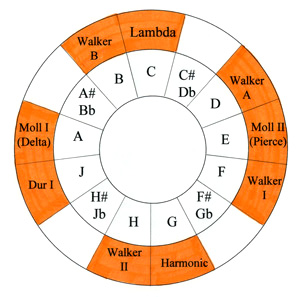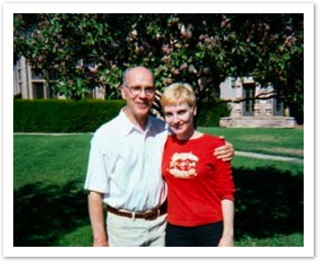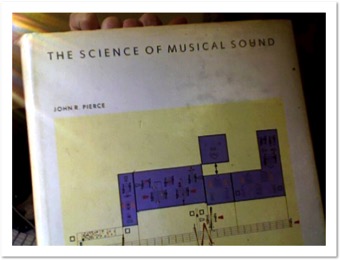Bohlen-Pierce Scale
The Bohlen-Pierce Scale has become one of the most well-known xenharmonic (microtonal/macrotonal) musical tunings, even though it's one of the most difficult to write music with. This page has a lot of information about the Bohlen-Pierce Scale, and I hope you enjoy going through it.
Quick note for clarity: Normally a musical tuning is called a tuning, and a scale would be a subset of that tuning, such as a "Major scale" is an 8 note subset of our normal 12 note piano tuning. But the Bohlen-Pierce Scale was invented by two microwave engineers (several years apart no less, and that amazing story is down below) and apparently neither was paying attention to music word conventions.
For Beginners:
In short, not all music is composed with the same notes and chords that pianos and guitars can play. Xenharmonic music uses tunings containing more or less notes than the usual 12 notes per octave. The Bohlen-Pierce Scale takes it a step further and doesn't even use an octave as the frame.
What is an octave, you ask?
An octave is the musical interval of two notes, where the waveform of the higher note is 2x the frequency of the low note. Any two notes with the same letter name will sound like the same note, except one will sound higher, like a child and their dad singing the same melody together. For example, all C's across a musical instrument are octaves apart.
Since the frequency doubles with each octave, the frequency grows exponentially as we play octaves sequentially from low to high. But to humans, each doubling sounds like the same interval size. The fact that octaves are all the same physical distance apart on a piano reflects this. But all that cool psychoacoustics stuff is beyond the scope of these paragraphs.
Returning to scales: Compare how 10 is the frame for our decimal numbering system to how an octave is the frame for most musical scales. As we count up, we anticipate getting to the next multiple of 10 (17, 18, 19.. 20!), and in a similar sense, we anticipate the next octave as we play up the notes of a scale.
The Bohlen-Pierce Scale uses a different frame than an octave, though. It is called a tritave!
A tritave is the equivalent of an octave plus a fifth, or 3x the frequency. In the case of the Bohlen-Pierce Scale, as we play up the steps in the scale, we should anticipate the next tritave–or so we'd hope. But, unlike the octave, the two notes of a tritave don't have the same pitch class. In other words, they don't sound like the same note like octaves do, and don't have that same "pull" on our brains. Since humans are generally wired to perceive octaves as the frame, we find it harder to experience the equivalent anticipation and satisfaction with tritaves.
It gets worse. In the Bohlen-Pierce Scale, there are no octaves. There is only one of every note across the hearing range. This fact can throw off standard composing techniques, such as "doubling up" a note of a chord progression with a baseline an octave lower. Those notes won't exist.
This tritave frame is divided into 13 steps to make the Bohlen Pierce Scale. So we say the Bohlen-Pierce Scale is "13 notes per tritave" instead of the usual "12 notes per octave." The consequence is that each step is slightly larger than what we're used to. (A semi-tone in BP sounds somewhere between a semi-tone and whole-tone in a 12 tone tuning, whereas a whole tone in BP sounds very much like a minor third in 12 tone. The fact that a whole-tone sounds like a standard minor third is why we hear minor 7th chords all over the place in BP music. Don't worry if you don't know what any of that means!)
Remember how I said above that tritaves were hard to hear as the frame of the tuning? Well, this isn't always the case. One day, after I had immersed myself in tonal Bohlen-Pierce Scale music for many years off and on, I heard the tritave as an octave – and it scared me! I thought I must be overly tired. But this has happened several times since then. Almost every time I compose a new song in BP, I experience this phenomenon. I'll ask myself, "How did an octave sneak into the music?" And then I realize, "Oh wow, that's a tritave! BP broke my brain!"
Our brains have dynamical attractors that pull on us when music lands on octaves, which happens quite frequently, to give us a feeling of stability and resolution. Whether musically trained or not, humans are wired to hear the octave as this frame. But if we deprive ourselves of octaves and instead immerse ourselves in an alien tuning that is not only devoid of octaves but also musically uses a different frame, our brains will eventually compensate. We'll adjust to hear the tritave as the frame.
So it must be more critical that there IS a frame and less important as to what it is. Listen to tonal Bohlen-Pierce Scale music long enough; you may someday hear the tritave sound like an octave. It's an extraordinary feeling.
Here is the main Bohlen-Pierce Scale website, formerly run by Heinz Bohlen: http://www.huygens-fokker.org/bpsite
Bohlen-Pierce Modes and Tunings: http://huygens-fokker.org/bpsite/modes.html

Some modes and chords are mapped out here, which you may find useful.
I will always cherish this image from the website. It's the Lambda family wheel that Heinz Bohlen drew in 2001. Read the fun story about it here.

[Go here for a full playlist.]
Involution | Involution YouTube (2023, Elaine Walker / No Terrestrial Road)
Magic Rectangle (2021, Elaine Walker / Four-Momentum)
Infinity | Infinity video performance (2019, Elaine Walker / Four-Momentum)
Euler's Identity (2018, Elaine Walker / Four-Momentum)
Love Song | Love Song live performance at Berklee | Love Song YouTube (2011, ZIA / Drum'n'Space)
Greater Good | Greater Good practicing at home | Greater Good YouTube (2011, ZIA / Drum'n'Space)
1-rx^2 Part1 | Part2 | Part3 | Part4 (1992, composed in MAX using Chaos Melody Theory)
Agribusiness (1992, ZIA / v1.5)
Stick Men | Stick Men live performance at Berklee (1992, ZIA / v1.5)
Dr. Richard Boulanger
I Know of No Geometry
Solemn Song for Evening (live performance at the Bohlen-Pierce Symposium 2010)
Sevish
Orbital (Bohlen-Pierce beat)
Mashroon (microtonal drum & bass, Bohlen Pierce scale)
Find more music on the main Bohlen-Pierce Scale website.
My lecture at the Bohlen-Pierce Scale Symposium, Boston 2010: 5 Videos
AXIS keyboard for the Bohlen-Pierce Scale: 11 Videos
Building a Bohlen-Pierce Scale Vertical Keyboard: 1 Video
Hearing Inversions in BP – Listening Examples: 4 Videos





Bohlen-Pierce keyboards are discussed here, as well as featured in the above videos.
Quick note for clarity: Normally a musical tuning is called a tuning, and a scale would be a subset of that tuning, such as a "Major scale" is an 8 note subset of our normal 12 note piano tuning. But the Bohlen-Pierce Scale was invented by two microwave engineers (several years apart no less, and that amazing story is down below) and apparently neither was paying attention to music word conventions.
For Beginners:
In short, not all music is composed with the same notes and chords that pianos and guitars can play. Xenharmonic music uses tunings containing more or less notes than the usual 12 notes per octave. The Bohlen-Pierce Scale takes it a step further and doesn't even use an octave as the frame.
What is an octave, you ask?
An octave is the musical interval of two notes, where the waveform of the higher note is 2x the frequency of the low note. Any two notes with the same letter name will sound like the same note, except one will sound higher, like a child and their dad singing the same melody together. For example, all C's across a musical instrument are octaves apart.
Since the frequency doubles with each octave, the frequency grows exponentially as we play octaves sequentially from low to high. But to humans, each doubling sounds like the same interval size. The fact that octaves are all the same physical distance apart on a piano reflects this. But all that cool psychoacoustics stuff is beyond the scope of these paragraphs.
Returning to scales: Compare how 10 is the frame for our decimal numbering system to how an octave is the frame for most musical scales. As we count up, we anticipate getting to the next multiple of 10 (17, 18, 19.. 20!), and in a similar sense, we anticipate the next octave as we play up the notes of a scale.
The Bohlen-Pierce Scale uses a different frame than an octave, though. It is called a tritave!
A tritave is the equivalent of an octave plus a fifth, or 3x the frequency. In the case of the Bohlen-Pierce Scale, as we play up the steps in the scale, we should anticipate the next tritave–or so we'd hope. But, unlike the octave, the two notes of a tritave don't have the same pitch class. In other words, they don't sound like the same note like octaves do, and don't have that same "pull" on our brains. Since humans are generally wired to perceive octaves as the frame, we find it harder to experience the equivalent anticipation and satisfaction with tritaves.
It gets worse. In the Bohlen-Pierce Scale, there are no octaves. There is only one of every note across the hearing range. This fact can throw off standard composing techniques, such as "doubling up" a note of a chord progression with a baseline an octave lower. Those notes won't exist.
This tritave frame is divided into 13 steps to make the Bohlen Pierce Scale. So we say the Bohlen-Pierce Scale is "13 notes per tritave" instead of the usual "12 notes per octave." The consequence is that each step is slightly larger than what we're used to. (A semi-tone in BP sounds somewhere between a semi-tone and whole-tone in a 12 tone tuning, whereas a whole tone in BP sounds very much like a minor third in 12 tone. The fact that a whole-tone sounds like a standard minor third is why we hear minor 7th chords all over the place in BP music. Don't worry if you don't know what any of that means!)
Remember how I said above that tritaves were hard to hear as the frame of the tuning? Well, this isn't always the case. One day, after I had immersed myself in tonal Bohlen-Pierce Scale music for many years off and on, I heard the tritave as an octave – and it scared me! I thought I must be overly tired. But this has happened several times since then. Almost every time I compose a new song in BP, I experience this phenomenon. I'll ask myself, "How did an octave sneak into the music?" And then I realize, "Oh wow, that's a tritave! BP broke my brain!"
Our brains have dynamical attractors that pull on us when music lands on octaves, which happens quite frequently, to give us a feeling of stability and resolution. Whether musically trained or not, humans are wired to hear the octave as this frame. But if we deprive ourselves of octaves and instead immerse ourselves in an alien tuning that is not only devoid of octaves but also musically uses a different frame, our brains will eventually compensate. We'll adjust to hear the tritave as the frame.
So it must be more critical that there IS a frame and less important as to what it is. Listen to tonal Bohlen-Pierce Scale music long enough; you may someday hear the tritave sound like an octave. It's an extraordinary feeling.
Research
I wrote this research paper on the Bohlen-Pierce Scale for an Advanced Acoustics class at New York University in the Spring of 2001 while obtaining my masters degree in Music Technology. It included listening tests with nine subjects who collectively had a wide variety of musical training. Some were beginners and some were long-time professional musicians.Here is the main Bohlen-Pierce Scale website, formerly run by Heinz Bohlen: http://www.huygens-fokker.org/bpsite
Bohlen-Pierce Modes and Tunings: http://huygens-fokker.org/bpsite/modes.html
Modes and Chords

Some modes and chords are mapped out here, which you may find useful.
I will always cherish this image from the website. It's the Lambda family wheel that Heinz Bohlen drew in 2001. Read the fun story about it here.

Listen to Bohlen-Pierce Scale music
Elaine Walker[Go here for a full playlist.]
Involution | Involution YouTube (2023, Elaine Walker / No Terrestrial Road)
Magic Rectangle (2021, Elaine Walker / Four-Momentum)
Infinity | Infinity video performance (2019, Elaine Walker / Four-Momentum)
Euler's Identity (2018, Elaine Walker / Four-Momentum)
Love Song | Love Song live performance at Berklee | Love Song YouTube (2011, ZIA / Drum'n'Space)
Greater Good | Greater Good practicing at home | Greater Good YouTube (2011, ZIA / Drum'n'Space)
1-rx^2 Part1 | Part2 | Part3 | Part4 (1992, composed in MAX using Chaos Melody Theory)
Agribusiness (1992, ZIA / v1.5)
Stick Men | Stick Men live performance at Berklee (1992, ZIA / v1.5)
Dr. Richard Boulanger
I Know of No Geometry
Solemn Song for Evening (live performance at the Bohlen-Pierce Symposium 2010)
Sevish
Orbital (Bohlen-Pierce beat)
Mashroon (microtonal drum & bass, Bohlen Pierce scale)
Find more music on the main Bohlen-Pierce Scale website.
Other videos
Bohlen-Pierce Scale Symposium, Boston 2010: Videos of Performances and LecturesMy lecture at the Bohlen-Pierce Scale Symposium, Boston 2010: 5 Videos
AXIS keyboard for the Bohlen-Pierce Scale: 11 Videos
Building a Bohlen-Pierce Scale Vertical Keyboard: 1 Video
Hearing Inversions in BP – Listening Examples: 4 Videos
Keyboards


Bohlen-Pierce keyboards are discussed here, as well as featured in the above videos.
The Two Inventors of the Bohlen-Pierce Scale

Heinz Bohlen at Stanford, 1935–2016
(Picture by Elaine Walker, 2001)

John Robinson Pierce, 1910–2002
(Picture courtesy of CCRMA, Stanford, CA)
The story of the Bohlen-Pierce Scale and it's inventors is a bittersweet one. Sadly, the two microwave engineers who invented the Scale independently six years apart, never met even though they both lived in the San Francisco area for a number of years. When John Pierce passed away in 2002, Heinz's dream of meeting him and discussing their co-invented scale in person, died with him. Heinz was also a fan of John Pierce because of his fame in the microwave engineering world. John Pierce is credited for inventing the idea of the communication satellite. In turn, John Pierce may have been envious that Heinz Bohlen invented the BP Scale six years before he did.
It all started in the early 1970s when Heinz Bohlen became curious as to why musicians always use the same 12 note per octave tuning. After getting some unsatisfactory answers from musicians, he took it upon himself to research music and tonality. It was finally the understanding of combination tones that lead him to believe he could use the same method that lead to the 12 tone equal temperament, to devise another tuning from a different framework. He understood that the 12 tone scale was based around the a major triad, the inversion, and then filling in the gaps. So, he started with a new triad that was very harmonically pure, but not contained within the normal 12 tone framework. He made the stunning discovery that a scale of thirteen almost equal steps within the framework of an octave and a fifth (which John Pierce later dubbed as a tritave) contained this very pure triad. He recognized that this tuning shared a duality with the traditional Western 12 tone tuning, it had harmonic value, and that it would be a valid compositional tool.
Amazingly, during the same time frame, another man named Kees van Prooijen had independently invented the BP Scale during his research in generic equal temperaments. But even more amazingly, a second microwave engineer named John R. Pierce made the same discovery, six years later. He arrived at the tuning using a different method, but for the same reason – Curiosity. Leave it to microwave engineers to invent a tuning with no octaves! When John Pierce realized it had already been invented by Heinz Bohlen, the tuning was dubbed the "Bohlen-Pierce Scale. He was apparently unaware of Kees van Proojijen. Coincidentally, John Pierce wrote "The Science of Musical Sound", which was my favorite childhood coffee table book. When my professor at Berklee College of Music, Dr. Boulanger, introduced me to the BP Scale in 1991, I knew the name John R. Pierce sounded familiar. That XMas I found the book in my parents living room and remembered how I loved the book when I was younger.
I had the pleasure of meeting Heinz Bohlen in 2001 in San Jose where he lived when I was on a trip to visit Stanford. We both ventured to Stanford looking for Max Mathews (the "Father of computer music"), but he was not there that week. We had hopes of having a grand reunion of Max Mathews, John Pierce, Heinz Bohlen, and myself. Dr. Richard Boulanger has also worked extensively with Max Mathews and John Pierce on Bohlen-Pierce Scale music and research. He informed me that John Pierce was in the hospital with Alzheimer's and was not taking visitors. Alas, the reunion never happened, but I found Heinz Bohlen to be delightful company over sushi. He took a great interest in my Chaos Melody Theory research and we talked about chaos theory more than the BP Scale! Heinz and I have kept in touch and remained friends ever since. – EW
Some background on the Bohlen-Pierce Scale and its inventors

Heinz and Elaine at Stanford, 2001

The Science of Musical Sound was my favorite childhood "coffee table" book. It's a coincidence. No joke!